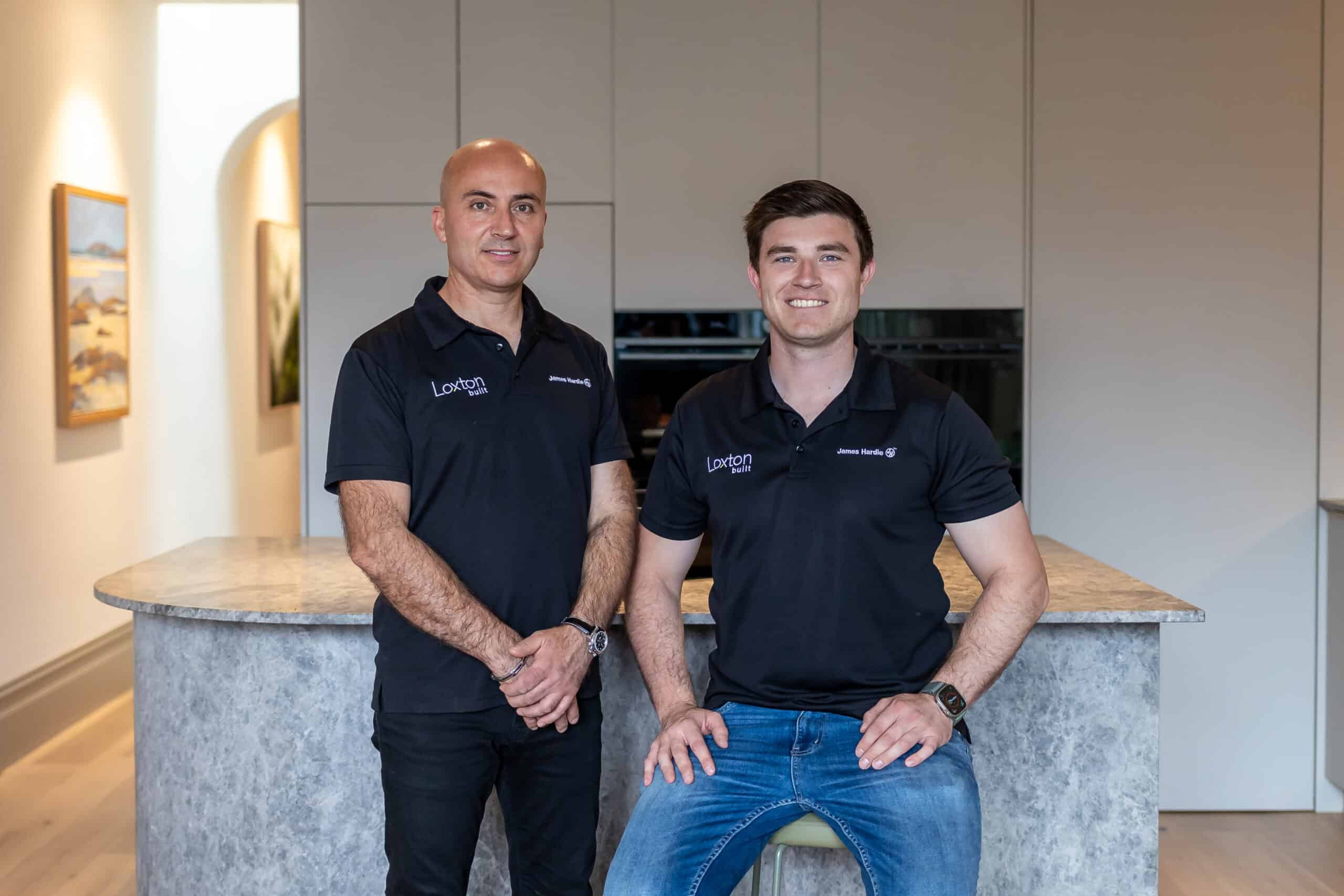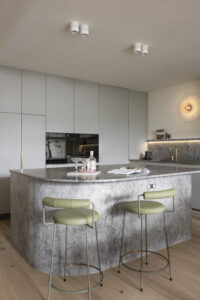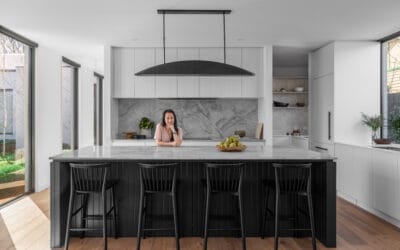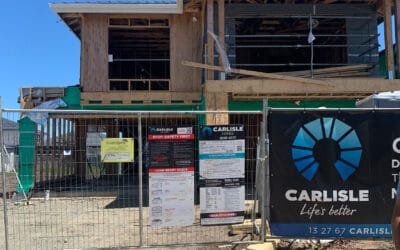For the latest in our Building Methods series, we’re joined by the very talented and experienced builder James Ind, Director of Loxton Built. With a double degree in Architecture and Construction Management, Master of Architecture and years of experience on site, James and his team work tirelessly to deliver unique, high quality residential homes.
When it comes to building their dream home, our BuildHers have developed a unique approach of collaboration in a ‘Blended Build’. James from Loxton Built is one builder that has been working with BuildHers in this way and we interviewed him to understand what he believes are the reasons behind this methods success and why it might be the right choice for your project.James, an experienced builder who has worked with six BuildHers to date recognises the significance of this process in providing a collaborative and communicative approach. He acknowledges that while collaboration is valued by builders, traditional projects often hit roadblocks which can be harder to overcome. The blended approach addresses these challenges directly and when managed well from both sides can result in a smoother building experience.

Peter Jardim & James Ind, Directors of Loxton Built – Photography | Dylan James
“Many women working with BuildHer have a keen interest in understanding the construction process. We encourage them to visit the construction site frequently, and we make sure it’s always safe and well-maintained. This hands-on experience enables our clients to be involved through the process and to learn more about the intricacies of construction, enhancing their knowledge of the process and experience of the build process.”
James has found that what sets the Blended BuildHer approach apart is its dedication to explaining the “why” behind construction decisions. When onsite if he or the trades encounter issues or constraints, they take the time to provide options on how to proceed and clear reasons for their choices in how to move forwards. This proactive communication helps avoid misunderstandings and fosters a more collaborative atmosphere, particularly where complete construction detailing has not been provided at the start of the build.
“It is fairly typical of an average build that complete resolution of structure and interiors has not been picked up in the design phase, so before construction begins, we make sure that we invest time in reviewing plans and addressing potential issues before they begin. This preparation allows us anticipate and mitigate problems.”
The success of the blended approach hinges on a collaborative relationship between clients, designers, and builders. Clear and consistent communication throughout the entire building process ensures that everyone is on the same page. This collaborative foundation minimises misunderstandings and maximises the effectiveness of the team, particularly where all the selections are not made before the project construction has been commenced. Some clients are visual and when seeing the space come together they can edit and tweak alongside the builder to ensure they are achieving the look and feel they desire.


Under the Elm Trees | Brighton – Photography | Jodie Johnson
So how do James and Loxton Built manage the Blended BuildHer model to ensure success?
A Focus on Relationship
James believes that the key lies in the relationships they’ve developed with BuildHer clients. Their collaborative approach and effective communication have been crucial – they understand what’s important to BuildHers and invest in educating them about the construction process. This ensures that clients are better prepared for their next project, as they’re equipped with the knowledge to make informed decisions. The success of this approach is a testament to the positive relationships they’ve fostered.
“We have seen that the BuildHers running this method with us appreciate the respect shown for their homes, and they have have a greater understanding of the process taken to build these spaces to the level they require.”
Control and Understanding of the Process
“Control and understanding are crucial – it’s about knowing where costs stand and effectively managing them throughout the project. Trust and collaboration are key along with the ability to work through challenges and communicate effectively to provide an ideal outcome. Managing clients and setting expectations of when and why decisions need to be made at key times from the project’s outset is crucial, ensuring they understand the potential implications of their decisions. It’s about making informed choices early on to avoid surprises and variations down the road.”
Minimising Variations as a Shared Goal
While variations can be an administrative burden and not in the best interest of clients or builders, they sometimes arise. When they do, the Loxton team works collaboratively with their clients to find solutions. They seek to balance any additional costs with savings in other project aspects, ultimately striving for a smoother and more cost-effective building experience.
The blended model offers benefits such as control, cost management, flexibility, and potentially faster project commencement. However, a solid working relationship is a prerequisite for its success. Without well-structured procurement schedules and internal processes, issues can arise, potentially straining the working relationship. It thrives when there is trust and a well-defined process in place.

Andrew Haus | Northcote – Photography | Dylan James
Scheduling and Procurement
The Loxton team has found that in an ideal scenario, all project specifications, including finishes and selections, would be decided before commencing the project for straightforward pricing. However, human nature and external factors can often lead to changes in preferences. Hence, flexibility in selections is created, working with clients to make choices and determine the associated costs. The primary goal is to ensure client satisfaction.
They manage this by working with their clients on their understanding of the build schedule, providing a procurement schedule in advance, which then allows clients to budget for various stages and understand when they need to order and supply different items. James has found that clear and effective communication is key and while this approach may require more effort, it has its advantages – it accommodates changes that often occur during a project.
Transparency in pricing from the project’s outset is critical while still providing the flexibility which is an essential component of the Blended Build model. James noted that some clients may opt for a build-to-lock-up and then take over the finishes, whilst others want to work with Loxton to the end of the build. The main advantage is that this process offers more flexibility, particularly helpful when there is a renovation component which can bring unknown variables. James finds that some clients need to see the space evolve before making certain decisions, discussing changes and their cost implications with them as they built. Whilst working in this manner and varying the build introduces a level of complexity, client satisfaction remains Loxton Built’s top priority, and it is probably why we have seen such an amazing response to the build experience from the BuildHers who have built with them.




Bonny House | Albert Park – Photography | Dylan James
The Blended BuildHer model has clear advantages, but it can also present complexities, especially if you are moving from a Blended BuildHer model to an Owner Builder model (where the home owner will manage everything after lock-up to finishing trades. This transition involves managing key trades, such as plumbers, electricians, and hydronic heating experts. Lock-up signifies a stage when the house is enclosed but not yet complete, with roughing-in tasks to be undertaken. Two options exist for this transition – the first is to have the builder manage their own in-ground trades, bringing in their own plumbers and electricians to complete the work. Once the building is handed over, the owner manages the finishing trades under this option. The second option is to have the owner’s plumbers and electricians handle the in-ground work, with the owner still responsible for the quality and outcome of the trades, as the finishing will be done after the builder’s handover.
Owner builders often consider taking on the finishing trades themselves, as the structural aspects may be daunting, but they feel comfortable with the finishing trades which can be tedious and time-consuming. Owner builders may appreciate the control they gain over the finishing stages of the project. However, potential pitfalls in this approach include issues like walls not being straightened, lack of back-blocking, and insufficient fixing points. These issues need careful attention for a successful outcome. Now, to be clear, James does not prefer this model, but understands that this does help some clients achieve the outcomes they need. James noted that clear definitions of each stage, including what lock-up entails, what is fixed after lock-up, and what follows next, must be established at the start.
Another factor to consider when transitioning from Blended Buildher to Owner Builder is the liability. Owner builders assume full liability, similar to experienced and qualified builders. Small details, such as freeboard requirements, can become problematic if they are overlooked in the initial phases. Liability for code compliance and the quality of work is a significant responsibility that owner builders must be aware of.
While the finishing stages can be demanding, the structural aspects of the project are equally challenging. Experienced builders have acquired knowledge and skills over the years, making them well-equipped to manage these complexities. Relying on trades alone to ensure compliance and quality is not advisable, as some may not be well-versed in compliance codes. Proper sequencing and project management are essential for a successful owner builder project.
James clearly has great and established trust with his clients that are using the Blended BuildHer model, we would caution that this approach needs to be collaborative and is suited to relationship-based builds where there is a lot of flexibility and give and take – it may not be suited to all BuildHers. Building can be a fun and enjoyable process, provided that the right approach is taken and that potential challenges are navigated effectively. This process is perfect for the hands on BuildHer who wants to learn and enjoy the building process but with the guided expertise of a builder like Loxton Built.
If you’ve missed them, make sure to check out the previous blogs and podcast episodes in our Building Methods series – an overview of the different methods, Owner Builder, Design Team and Tender and Volume Build methods! Which one is right for you?
Interested in diving deep into property development and becoming a DevelopHer? Book a call HERE, to discover how you too can renovate or build for profit, and change your life!







